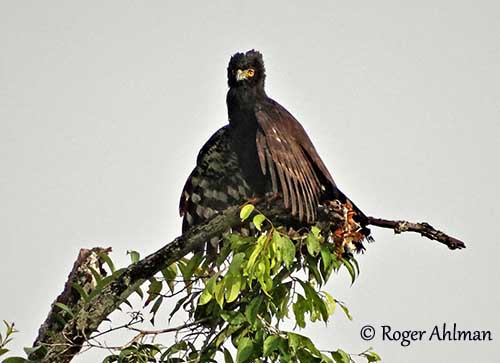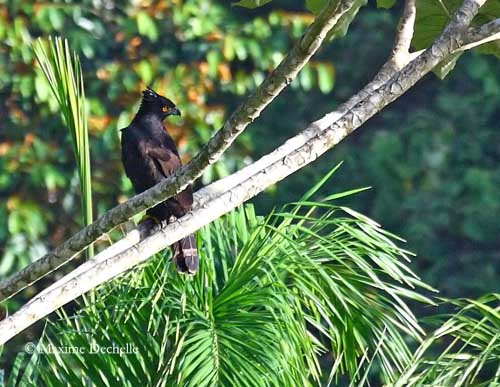
PROTECTION / THREATS / STATUS:
The Black Hawk-Eagle can be relatively common in suitable habitat, but the species is threatened by deforestation and agriculture expansion is most parts of the range. Hunting is another problem in some locations too.
The population was estimated to number less than 50,000 individuals in 2008, and it is now suspected to decline.
But currently, the Black Hawk-Eagle is evaluated as Least Concern.
Fr: Aigle tyran
Ang: Black Hawk-Eagle
All: Tyrannenadler
Esp: Águila negra
Ita: Spizaeto nero
Nd: Zwarte Kuifarend
Sd: Svart hökörn
Port: Gavião-pega-macaco
Photographers:
Roger Ahlman
Pbase Galleries Peru and Ecuador
Marc Chrétien
MURINUS
Maxime Dechelle
LEPAPARRAZO
Ken Havard
My Bird Gallery & Flickr gallery 1 & Flickr gallery 2
Text by Nicole Bouglouan
Sources :
HANDBOOK OF THE BIRDS OF THE WORLD Vol 2 by Josep del Hoyo-Andrew Elliot-Jordi Sargatal - Lynx Edicions - ISBN: 8487334156
A GUIDE TO THE BIRDS OF COLOMBIA by Steven L. Hilty and William L. Brown - Princeton University Press – ISBN 069108372X
A GUIDE TO THE BIRDS OF MEXICO AND NORTHERN CENTRAL AMERICA by Steve N. G. Howell, Sophie Webb - Oxford University Press - ISBN: 0198540124
BirdLife International (BirdLife International)
Neotropical Birds – Cornell Lab of Ornithology
Global Raptor Information Network - Working to Conserve Birds of Prey in nature
Wikipedia, the free encyclopaedia


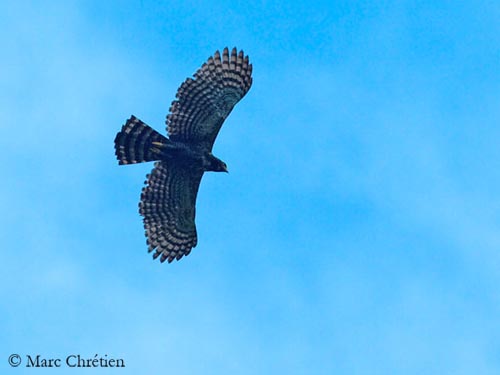
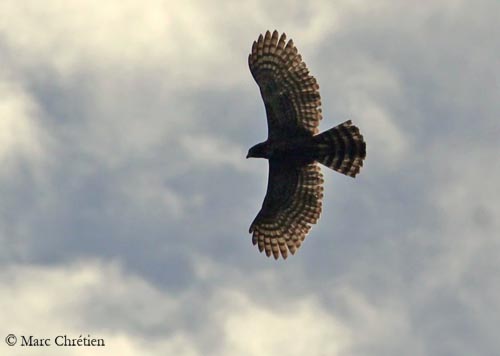
Black Hawk-Eagle
Spizaetus tyrannus
Accipitriformes Order – Accipitridae Family
INTRODUCTION:
The Black Hawk-Eagle is included in the genus Spizaetus in the Booted Eagle’s group. This species is found in Central and South America. This powerful predator is able to kill large preys such as opossums and monkeys. It lives in tropical forests from lowlands up to 2000-3000 metres of elevation.
The Black Hawk-Eagle is threatened by habitat loss due to deforestation, and its population is suspected to decline, although being currently evaluated as Least Concern.
DESCRIPTION OF THE BIRD:
Biometrics:
Length: 61-74 cm
Wingspan: 127-155 cm
Weight: M: 880-960 g – F: 1090-1150 g
The adult has glossy black plumage overall, with short, bushy occipital crest basally white. This feature is often obvious but sometimes indistinct.
The wings are long, broad and rounded, and the tail is long and rounded too. The wingtips reach the base of the tail at rest. The tail is barred black and pale grey, with narrow whitish tip. There are three pale grey bands on the uppertail and three whitish bands on the undertail.
On the underparts, the underwing-coverts are black with some white flecks visible only at close range. The flight feathers are checkered black-and-white. Tarsi, thighs and undertail-coverts are narrowly but conspicuously barred white.
The bill is blackish with slate grey cere. The eyes are golden yellow. The feet are yellow with black claws.
The female has similar plumage but she is larger than male.
The juvenile has white throat, forehead, supercilium and tip of crest. On the head, crown and crest are mottled black-and-white, while ear-coverts and cheeks are black.
The upperparts are browner than in adult. On the underparts, the breast is streaked brown and black and the belly is mottled black-and-white.
It attains the adult plumage at 2-3 years old.
SUBSPECIES AND RANGE:
The Black Hawk-Eagle has two subspecies.
S.t. serus occurs from S Mexico, S through Central America to Colombia, and then E of Andes to E Venezuela, Trinidad and the Guianas, and S to E Peru, Bolivia and N & C Brazil. Also W of Andes in W Ecuador and extreme NW Peru.
This race is smaller and less marked on the underwing-coverts, whereas flanks, thighs and legs show more distinct white barring.
S.t. tyrannus is found in E & S Brazil, E Paraguay and extreme NE Argentina.
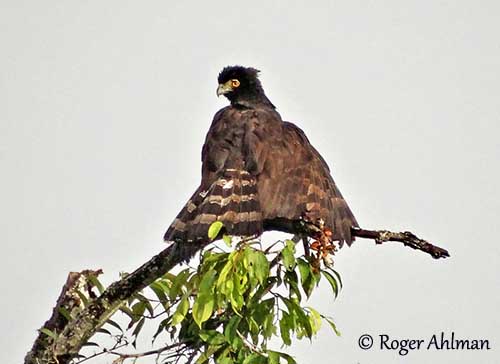
HABITAT:
The Black Hawk-Eagle frequents humid evergreen forest and semi-deciduous forest. It is locally fairly common at forest edges, in second-growth woodland and along natural semi-open habitat and rivers in extensive forests.
CALLS AND SONGS: SOUNDS BY XENO-CANTO
The Black Hawk-Eagle often calls while soaring and utters loud, clear whistles, a drawn-out “whi, whi-wheeooo” or “wh whee-hoo” and “wheeoo” preceded by several introductory notes such as “whi whi…wheeoo” or “wh wh… wee-oo”.
The adults give a single “weeoo” when perched, and soft whistles on or near the nest.
BEHAVIOUR IN THE WILD:
The Black Hawk-Eagle feeds on various animals such as large birds including toucans, chachalacas and macaws, also arboreal mammals such as squirrels, bats, opossums and monkeys. Reptiles including lizards or iguanas and snakes are taken too. The diet varies according to the range.
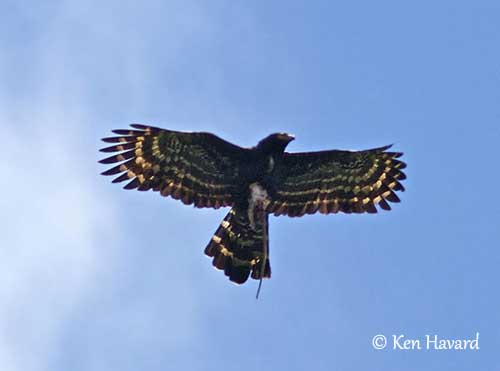
S.t. tyrannus
With a snake in the talons
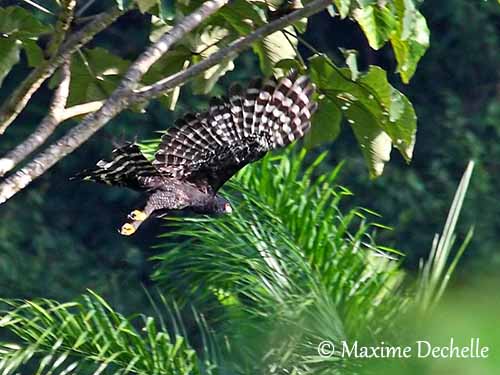
It hunts mostly from perch from where it performs rapid flights. It moves from tree to tree, listening and looking for preys. It flies from the perch with great speed in order to ambush and pursue the prey in rapid chases.
During the breeding season, the Black Hawk-Eagle performs spectacular aerial displays, typical of Booted eagles, with contact in the air between mates by grasping their talons, and roll-overs.
They soar above the nesting area as territorial behaviour. This raptor is generally seen alone, and occasionally in pairs especially during the breeding season.
The Black Hawk-Eagle is probably sedentary in its range. Some local dispersion is observed, and this species is vagrant to Trinidad.
It soars frequently and high in the air, usually in the second half of the morning. It flies with deep, powerful wingbeats. The wings are held flattish and the tail is slightly spread.
REPRODUCTION OF THIS SPECIES:
The breeding season takes place between December and August. They usually breed only once every 2-3 years.
The stick nest is large, up to 140 cm wide and 55 cm deep. It is placed high in tree, from 17-23 metres to 23-28 metres depending on tree species.
The female lays a single white egg, rarely two. The incubation lasts 42-45 days mainly by female, while the male feeds her during this period.
At hatching, the chick has white down, but the dark plumage appears after five weeks. It is fed by both adults, but mainly by the male towards the end of the cycle. It fledges about 69-70 days after hatching. The young is occasionally attacked at nest by large monkeys.
It usually remains in the vicinity of the nest (within 150 metres) during one year, as the fledgling dependency period is long.
